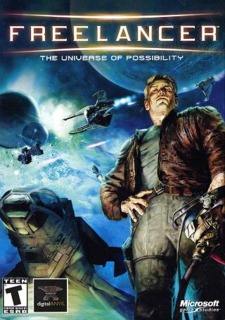Freelancer
Naturally, with a game this long in development, the impact of its technical luster has faded significantly. Had it come out a year ago, Freelancer would be leading its genre in terms of visual bedazzlement. As it stands, it still manages to hold its own with other cutting-edge titles, which is a testament of sorts to the vision of its initial design.
Every detail — the ships, explosions, space stations, and planets — looks great, and the game performs admirably well with all effects turned on at high resolutions on the recommended configuration. It has a bold cinematic flair, but it’s just not as awe-inspiring as I’d hoped, which again can probably be attributed mostly to its delayed arrival.
The story and gameplay are akin to Morrowind’s in many respects. A central scripted plot serves to lead your character, Edison Trent, through about half of Freelancer’s “known” star systems before it’s done, introducing you to around 20 principal NPCs. Missions range from escorts to running for your life to finding and taking out bases, as well as locating various people and items.
However, you don’t have to progress directly from one story mission to the next. In fact, the game’s leveling-up scheme actually requires you to take time between story objectives to “freelance” and raise the necessary cash and experience needed to acquire that next, more-powerful fighter ship.
The main story took me only about 13 hours to get through, and then I was free to do whatever I wanted. The free-form play entails exploring the rest of the systems, making a living out of the trade system (buying low, selling high), becoming a nefarious space pirate, or upholding the law by freelancing for the military and/or police.
Whichever role you choose for yourself, the process of fulfilling it consists of finding and visiting planets and space stations, then going to their bars to drum up business with the patrons, or simply taking a look at the job board for available assignments. While docked, you can also purchase a new ship, repair and upgrade your existing one, and buy or sell commodities.
The missions you choose, fights you join, and cargo you loot all have an effect on your reputation. They’ll win you fast friends and hard enemies — with long memories — among the game’s numerous factions, which may make it impossible to land on certain bases or planets, as well as hinder your travel in certain sectors.
Unfortunately, while each star system manages to pull off a unique look (Asian, European, American, or alien in theme), the people you meet are far more one-dimensional. The canned conversation options are extremely limited, and you’ll say the same lines over and over again and hear the same ones back in return. The missions lack the variety to keep you bent on seeking out new ways to make a space credit.
MAKE A SPACE LIVING
The prospect of earning more cash and levels to gain access to the game’s more powerful ships is still alluring. But the “freelancing” aspect suffers from the lack of any motivating factor. The ability to buy or own property where you could warehouse different ships, or even earning enough dough to buy your own planet, would have greatly enhanced the freelancing, which is the real heart of the game. (It is called Freelancer, after all.) Even the prospect of encountering the odd NPC with a sub-quest or two would have been a wise addition.
Freelancer’s cooperative multiplayer options help make up for this shortcoming. Being able to hook up with several friends and explore the galaxy together, taking on the higher-level missions and searching for the myriad “secrets” strewn about the various systems, is great fun. Multiplayer games performed quite well over my DSL connection, with nary a framerate drop or perceptible lag in onscreen action. Of course, you can also host or join a player-versus-player server for some deathmatching action.
The 100-percent mouse-driven control scheme may leave many space-sim grognards flat, as it did me at first — and it still takes some of the edge out of deathmatching for me. Not being able to use my fancy joystick to fly with, as I could with all of original designer Chris Roberts’ previous space efforts, just seems unnatural. I understand the desire to make the game friendly to new players, but I do miss some of the additional sophisticated control options typically offered in games of this type, including the ability to issue orders to wingmen and to target specific parts of ships.
Still, using the mouse makes precision-aiming and movement easier, which is a plus considering all the dense asteroid and debris fields you’ll have to fly and fight your way through. And it’s easier to switch between flying and navigating the brilliantly simplified interface using a dedicated mouse-control scheme. I’d still like to see joystick support, and the ability to roll your ship is conspicuously absent, but the mouse-driven controls work pretty smoothly overall.
Freelancer suffers from a severe lack of character development in almost every nook and cranny of its design. But it offers an interesting main story, bottomless value for the dollar in terms of sheer open-ended exploration, and a very cool co-op mode. Given the current drought befalling this genre, Freelancer is easy to recommend to space simmers.

